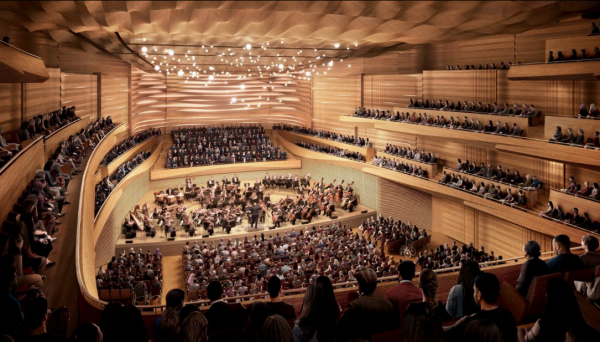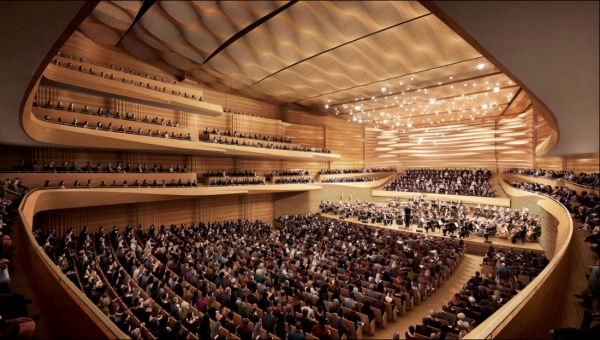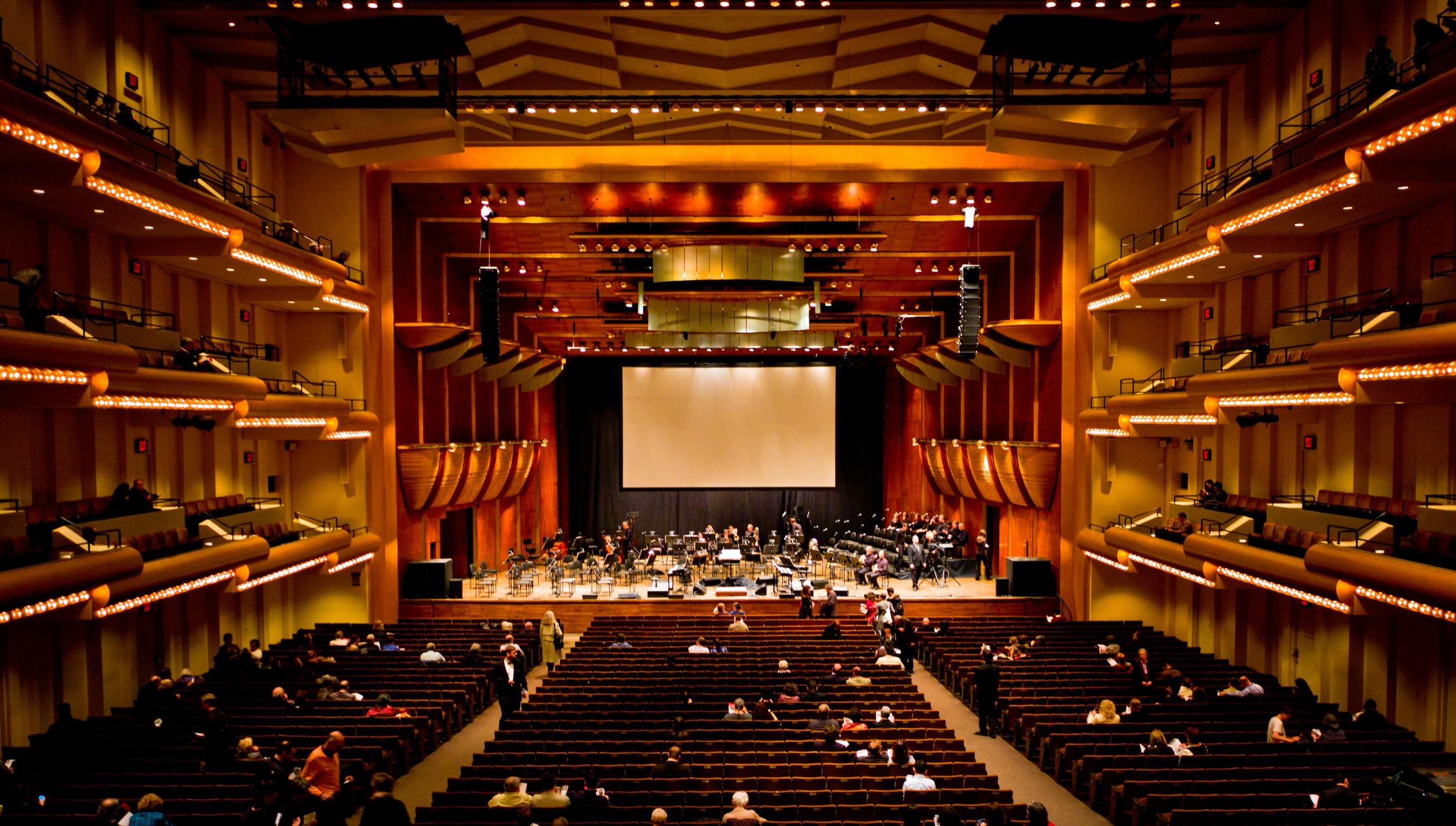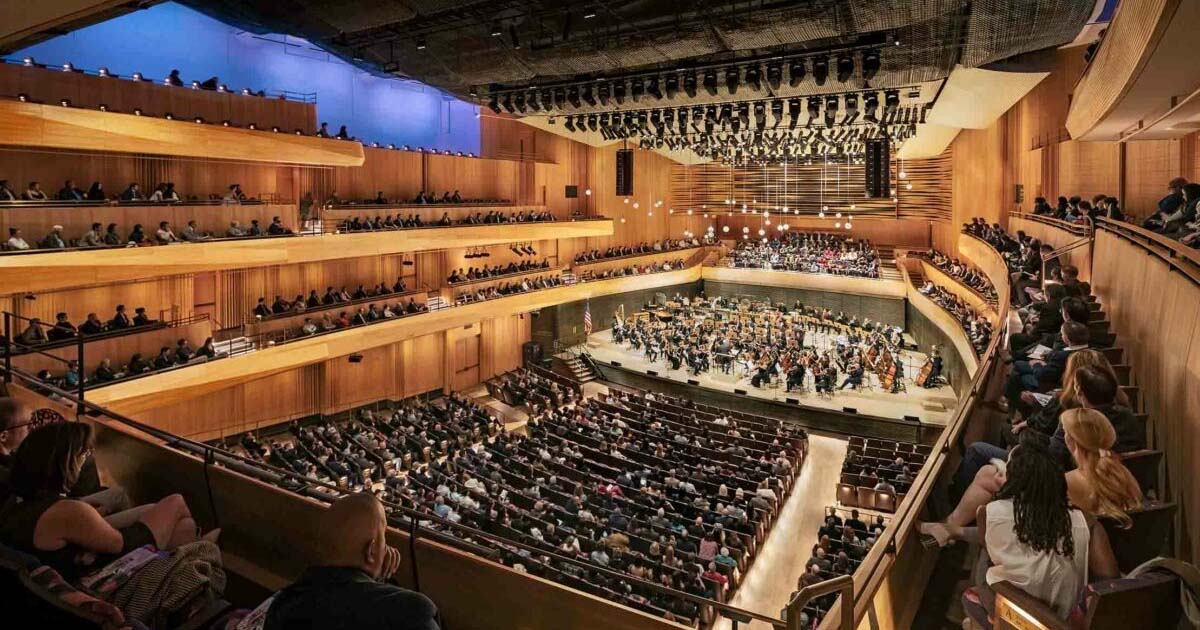Today, Lincoln Center announced it's long awaited plan to renovate and remodel David Geffen Hall, the home of the NY Philharmonic. As many may know, this venue has had a tortured past which is detailed below. However, the current plans and some images are as follows:
Construction at David Geffen Hall will begin May 2022. There will be two brief closures while the work is completed:


The acoustic history of the hall is interesting. The following is excerpted from Wikipedia:
"The facility, designed by Max Abramovitz, was originally named Philharmonic Hall and was renamed Avery Fisher Hall in honor of philanthropist Avery Fisher, who donated $10.5 million ($59 million today) to the orchestra in 1973. In November 2014, Lincoln Center officials announced Fisher's name would be removed from the Hall so that naming rights could be sold to the highest bidder as part of a $500 million fund-raising campaign to refurbish the Hall. In 2015, the hall was renamed David Geffen Hall after Geffen donated $100 million to the Lincoln Center.
The hall underwent renovations in 1976 to address acoustical problems that had existed since it opened. Another smaller renovation attempted to address unresolved problems in 1992. Both projects achieved limited success.
In May 2004, the orchestra announced that the building would undergo renovations in 2009, but in June 2006, The New York Times reported that the construction had been delayed until the summer of 2010. By 2012, it became clear that construction would not start before 2017. The shell of the building was to be left intact and work was to focus on improving the hall's acoustics, modernizing patron amenities and reconfiguring the auditorium. On October 3, 2017, it was announced that existing renovation plans for the Hall had been scrapped.
Architects hired the acoustical consulting division of Bolt, Beranek and Newman (BBN) to design the original interior acoustics for the hall. Their acousticians recommended a 2,400 seat "shoebox" design with narrowly spaced parallel sides (similar in shape to the acoustically acclaimed Symphony Hall, Boston). Lincoln Center officials initially agreed with the recommendation, and BBN provided a series of design specifications and recommendations. However, the New York Herald Tribune began a campaign to increase the seating capacity of the new hall and late in the design stage it was expanded to accommodate the critics' desires, invalidating much of BBN's acoustical work. BBN engineers told Lincoln Center management the hall would sound different from their initial intent, but they could not predict what the changes would do.
The first of Lincoln Center's buildings to be completed, Philharmonic Hall opened September 23, 1962, to mixed reviews. Several reporters panned the hall, while at least two conductors praised the acoustics. While the initial intention had been that Philharmonic Hall would replace Carnegie Hall, which could then be demolished, that scenario did not take place.
Management made several attempts to remedy the induced acoustical problems, with little success, leading to a substantial 1970s renovation designed by acoustician Cyril Harris in conjunction with project architect Philip Johnson. It included demolishing the hall's interior, selling its pipe organ to California's Crystal Cathedral, and rebuilding a new auditorium within the outer framework and facade. While initial reaction to the improvements was favorable and some advocates remained steadfast, overall feelings about the new hall's sound soured and acoustics there continued to be problematic. One assessment by Robert C. Ehle stated:
The seating capacity is large (around 2,600 seats) and the sidewalls are too far apart to provide early reflections to the center seats. The ceiling is high to increase reverberation time but the clouds are too high to reinforce early reflections adequately. The bass is weak because the very large stage does not adequately reinforce the low string instruments."
Will the extensive renovations be successful? Who knows? But it is interesting that Leo Beranek, the godfather of concert hall acoustics said in his famous survey of great halls written shortly before his death a number of years ago, that the hall's exterior shell of cinder block construction would almost assure that any future rehabilitation efforts would not be met with great success. I guess we shall see. What's annoying is that after many years, I finally found the only two rows in the center orchestra seating where the sound is decent. Now, I'll have to start over again! Still, it's exciting and I'm looking forward to hearing the results of this latest effort.
Construction at David Geffen Hall will begin May 2022. There will be two brief closures while the work is completed:
- May 2022 through October 2022, after which the hall will reopen for a concert season, running from November 2022 through April 2023
- May 2023 through February 2024, during which the Orchestra will perform in New York City venues, most often at Carnegie Hall and New York City Center.


The acoustic history of the hall is interesting. The following is excerpted from Wikipedia:
"The facility, designed by Max Abramovitz, was originally named Philharmonic Hall and was renamed Avery Fisher Hall in honor of philanthropist Avery Fisher, who donated $10.5 million ($59 million today) to the orchestra in 1973. In November 2014, Lincoln Center officials announced Fisher's name would be removed from the Hall so that naming rights could be sold to the highest bidder as part of a $500 million fund-raising campaign to refurbish the Hall. In 2015, the hall was renamed David Geffen Hall after Geffen donated $100 million to the Lincoln Center.
The hall underwent renovations in 1976 to address acoustical problems that had existed since it opened. Another smaller renovation attempted to address unresolved problems in 1992. Both projects achieved limited success.
In May 2004, the orchestra announced that the building would undergo renovations in 2009, but in June 2006, The New York Times reported that the construction had been delayed until the summer of 2010. By 2012, it became clear that construction would not start before 2017. The shell of the building was to be left intact and work was to focus on improving the hall's acoustics, modernizing patron amenities and reconfiguring the auditorium. On October 3, 2017, it was announced that existing renovation plans for the Hall had been scrapped.
Architects hired the acoustical consulting division of Bolt, Beranek and Newman (BBN) to design the original interior acoustics for the hall. Their acousticians recommended a 2,400 seat "shoebox" design with narrowly spaced parallel sides (similar in shape to the acoustically acclaimed Symphony Hall, Boston). Lincoln Center officials initially agreed with the recommendation, and BBN provided a series of design specifications and recommendations. However, the New York Herald Tribune began a campaign to increase the seating capacity of the new hall and late in the design stage it was expanded to accommodate the critics' desires, invalidating much of BBN's acoustical work. BBN engineers told Lincoln Center management the hall would sound different from their initial intent, but they could not predict what the changes would do.
The first of Lincoln Center's buildings to be completed, Philharmonic Hall opened September 23, 1962, to mixed reviews. Several reporters panned the hall, while at least two conductors praised the acoustics. While the initial intention had been that Philharmonic Hall would replace Carnegie Hall, which could then be demolished, that scenario did not take place.
Management made several attempts to remedy the induced acoustical problems, with little success, leading to a substantial 1970s renovation designed by acoustician Cyril Harris in conjunction with project architect Philip Johnson. It included demolishing the hall's interior, selling its pipe organ to California's Crystal Cathedral, and rebuilding a new auditorium within the outer framework and facade. While initial reaction to the improvements was favorable and some advocates remained steadfast, overall feelings about the new hall's sound soured and acoustics there continued to be problematic. One assessment by Robert C. Ehle stated:
The seating capacity is large (around 2,600 seats) and the sidewalls are too far apart to provide early reflections to the center seats. The ceiling is high to increase reverberation time but the clouds are too high to reinforce early reflections adequately. The bass is weak because the very large stage does not adequately reinforce the low string instruments."
Will the extensive renovations be successful? Who knows? But it is interesting that Leo Beranek, the godfather of concert hall acoustics said in his famous survey of great halls written shortly before his death a number of years ago, that the hall's exterior shell of cinder block construction would almost assure that any future rehabilitation efforts would not be met with great success. I guess we shall see. What's annoying is that after many years, I finally found the only two rows in the center orchestra seating where the sound is decent. Now, I'll have to start over again! Still, it's exciting and I'm looking forward to hearing the results of this latest effort.
Last edited:




